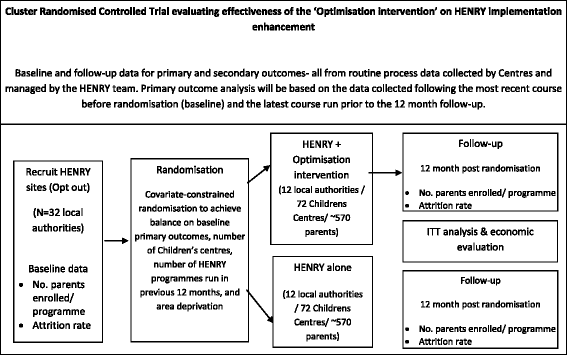Effectiveness of an implementation optimisation intervention aimed at increasing parent engagement in HENRY, a childhood obesity prevention programme - the Optimising Family Engagement in HENRY (OFTEN) trial: study protocol for a randomised controlled trial
- PMID: 28115006
- PMCID: PMC5260000
- DOI: 10.1186/s13063-016-1732-3
Effectiveness of an implementation optimisation intervention aimed at increasing parent engagement in HENRY, a childhood obesity prevention programme - the Optimising Family Engagement in HENRY (OFTEN) trial: study protocol for a randomised controlled trial
Abstract
Background: Family-based interventions to prevent childhood obesity depend upon parents' taking action to improve diet and other lifestyle behaviours in their families. Programmes that attract and retain high numbers of parents provide an enhanced opportunity to improve public health and are also likely to be more cost-effective than those that do not. We have developed a theory-informed optimisation intervention to promote parent engagement within an existing childhood obesity prevention group programme, HENRY (Health Exercise Nutrition for the Really Young). Here, we describe a proposal to evaluate the effectiveness of this optimisation intervention in regard to the engagement of parents and cost-effectiveness.
Methods/design: The Optimising Family Engagement in HENRY (OFTEN) trial is a cluster randomised controlled trial being conducted across 24 local authorities (approximately 144 children's centres) which currently deliver HENRY programmes. The primary outcome will be parental enrolment and attendance at the HENRY programme, assessed using routinely collected process data. Cost-effectiveness will be presented in terms of primary outcomes using acceptability curves and through eliciting the willingness to pay for the optimisation from HENRY commissioners. Secondary outcomes include the longitudinal impact of the optimisation, parent-reported infant intake of fruits and vegetables (as a proxy to compliance) and other parent-reported family habits and lifestyle.
Discussion: This innovative trial will provide evidence on the implementation of a theory-informed optimisation intervention to promote parent engagement in HENRY, a community-based childhood obesity prevention programme. The findings will be generalisable to other interventions delivered to parents in other community-based environments. This research meets the expressed needs of commissioners, children's centres and parents to optimise the potential impact that HENRY has on obesity prevention. A subsequent cluster randomised controlled pilot trial is planned to determine the practicality of undertaking a definitive trial to robustly evaluate the effectiveness and cost-effectiveness of the optimised intervention on childhood obesity prevention.
Trial registration: ClinicalTrials.gov identifier: NCT02675699 . Registered on 4 February 2016.
Keywords: Childhood obesity; Engagement; Implementation; Parent; Recruitment; Trial.
Figures
References
-
- Lifestyles Statistics Team, Health and Social Care Information Centre, Department of Health . National Child Measurement Programme: England 2014/15 school year. London: NHS Digital; 2015.
Publication types
MeSH terms
Associated data
Grants and funding
LinkOut - more resources
Full Text Sources
Other Literature Sources
Medical



